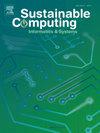混合元启发式算法考虑可持续计算的可再生/不可再生资源和固定存储系统多微电网柔性调节经济能源调度
IF 5.7
3区 计算机科学
Q1 COMPUTER SCIENCE, HARDWARE & ARCHITECTURE
引用次数: 0
摘要
该方案通过对微网环境、经济、灵活性、运行和安全指标的估计,提出了多微网配电网的能源调度方案。微电网采用多总线结构,包括可再生太阳能、风能和生物废物装置、不可再生资源、压缩空气和氢气储存。研究包含三个优化目标。目标函数为微电网运行成本和资源成本最小化、微电网环境污染最小化和电压偏差函数。该问题的约束条件包括基于柔性和电压安全限制的微电网最优潮流公式、可再生/不可再生机组性能模型和存储设备。研究的参数有能源价格、负荷和可再生现象等不确定性。在对其建模时,采用点估计方法,计算时间短,模型灵活准确。采用ε约束方法提取单目标模型,采用模糊决策技术实现折中解。该格式具有非凸非线性形式。为了在考虑最后一点偏差小的情况下获得可靠的响应,采用了小熊猫优化和蚁狮优化相结合的方法。资金表明计划改善微电网的技术、环境和经济条件的能力。因此,上述机组和储能系统的能源调度可分别改善微电网运行、经济、环境和电压稳定条件,分别改善59.2% %、44.2% %、24.5% %- 75% %和17.3% %-27.4 %。在这些条件下,研究实现了100% %的微电网灵活性。求解方法实现了可持续的计算条件,使其在较低的计算时间下具有最优解,最终响应的标准差为0.97 %。本文章由计算机程序翻译,如有差异,请以英文原文为准。
Flexibility regulation-based economic energy scheduling in multi-microgrids with renewable/non-renewable resource and stationary storage systems considering sustainable computing by hybrid metaheuristic algorithm
This plan presents energy scheduling in a distribution grid with multi-microgrid according to estimation of environmental, economic, flexibility, operation, and security indicators in microgrids. Microgrid has a multi-bus structure, which includes renewable solar, wind and bio-waste devices, non-renewable resources, compressed air and hydrogen storage. Study contains the three objectives optimization. The objective functions are the minimization of operation cost of microgrids and resources, the environmental pollution of microgrids and voltage deviation function. The constraints of the problem include the optimal power flow formulation of microgrids based on the flexibility and voltage security limits, the performance model of renewable/non-renewable units, and storage devices. Study has parameters of price of energy, load, and renewable phenomena as uncertainty. For their modeling, the point estimation approach is used to according to low computational time and accurately model flexibility. The ε-constraint method is used to extract the single-objective model, and fuzzy decision-making technique is used to achieve the compromise solution. This scheme has a non-convex nonlinear formulation. To access a reliable response considering low deviation for last point, a combination of red panda optimization and ant-lion optimization is used. Funding indicate the ability of plan for improve the technical, environmental, and economic conditions of microgrids. Thus, energy scheduling of the aforementioned units and storages can improve operational, economic, environmental, and voltage stability conditions of microgrids by about 59.2 %, 44.2 %, 24.5 %-75 % and 17.3 %-27.4 %, respectively. In these conditions, study achieves 100 % flexibility for microgrids. Solution approach achieves the sustainable computing conditions, such that it has the most optimal solution at low computational time and a standard deviation of 0.97 % in the final response.
求助全文
通过发布文献求助,成功后即可免费获取论文全文。
去求助
来源期刊

Sustainable Computing-Informatics & Systems
COMPUTER SCIENCE, HARDWARE & ARCHITECTUREC-COMPUTER SCIENCE, INFORMATION SYSTEMS
CiteScore
10.70
自引率
4.40%
发文量
142
期刊介绍:
Sustainable computing is a rapidly expanding research area spanning the fields of computer science and engineering, electrical engineering as well as other engineering disciplines. The aim of Sustainable Computing: Informatics and Systems (SUSCOM) is to publish the myriad research findings related to energy-aware and thermal-aware management of computing resource. Equally important is a spectrum of related research issues such as applications of computing that can have ecological and societal impacts. SUSCOM publishes original and timely research papers and survey articles in current areas of power, energy, temperature, and environment related research areas of current importance to readers. SUSCOM has an editorial board comprising prominent researchers from around the world and selects competitively evaluated peer-reviewed papers.
 求助内容:
求助内容: 应助结果提醒方式:
应助结果提醒方式:


